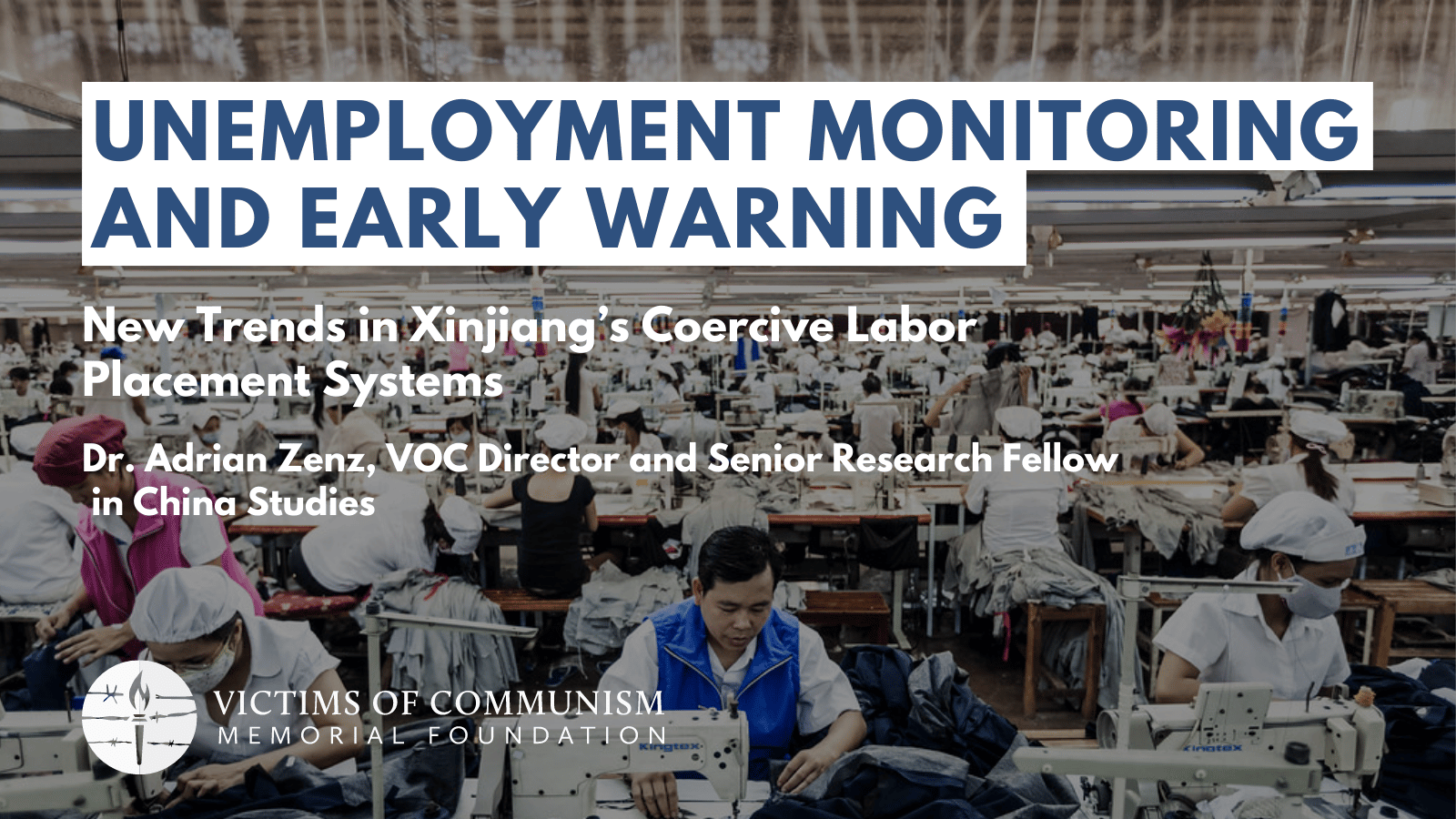Unemployment Monitoring and Early Warning: New Trends in Xinjiang’s Coercive Labor Placement Systems
Early warning brief published with The Jamestown Foundation
Summary
Dr. Adrian Zenz is one of the world’s leading scholars on People’s Republic of China (PRC) government policies towards the country’s western regions of Tibet and Xinjiang. In 2017-2018, Dr. Zenz’s analysis played a significant role in bringing to light the Chinese government’s campaign of repression and mass internment directed against ethnic Uyghur persons in Xinjiang. He has played a leading role in the analysis of leaked Chinese government documents, including the “China Cables,” the “Karakax List,” the “Xinjiang Papers,” and the “Xinjiang Police Files.”
In this report, Dr. Zenz details important updates on the status of forced labor policies in Xinjiang and contributes substantially to the case for why the EU and European national governments need a US-style import ban to ensure compliance with international labor norms and that their domestic businesses and consumers are not directly or indirectly supporting forced labor in China.
Introduction
In mid-2019, the first efforts to systematically research and conceptualize state-sponsored forced labor systems in the Xinjiang Uyghur Autonomous Region (XUAR) took place (Journal of Political Risk, December 2019). First, this research examined the placement of detainees in Vocational Skills Education and Training Centers (VSETCs, 职业技能教育培训中心, zhiye jineng jiaoyu peixun zhongxin), which function as re-education camps; and second, the findings detailed the transfer of rural surplus laborers (农村劳动者转移就业, nongcun laodongzhe zhuanyi jiuye) into secondary or tertiary sector work – referred to as Poverty Alleviation through Labor Transfer (脱贫转移就业, tuopin zhuanyi jiuye). In addition to general evidence for coercive labor placements into labor-intensive manufacturing, scholars uncovered evidence of coercive labor transfers for specific economic sectors such as cotton and tomato picking, as well as the production of polysilicon for solar panels (Newlines Institute, December 2020; CBC News, October 29, 2021; Bloomberg, April 2021).[1] Much of the evidence implicating these industries came from publicly available government data, media or company reports, typically dating from between 2017 and 2020. Unfortunately, since then, such evidence has become much sparser. This examination argues that this falloff in information is not just due to government censorship. Rather, it also reflects systemic and concerning changes to the ways that coercive labor placements in Xinjiang are being consolidated.
After the successes of the highly mobilizational labor placement efforts between 2016 and 2020, Xinjiang’s current (14th) Five-Year Plan (2021-2025) focuses on consolidating and maintaining these outcomes through unemployment and poverty prevention and surveillance mechanisms. Individuals who were coercively mobilized into work placements are now effectively prevented from leaving them. Since 2021, hundreds of thousands of cadres are conducting real-time monitoring of rural Uyghurs’ employment and income status. This general shift away from mobilizational to more institutionalized and monitored forms of labor placement simultaneously reduces the publication of specific evidence (propaganda texts) that typically accompany such campaign-style experimental efforts, while intensifying and institutionalizing the risk of coercion. Despite the decrease in concrete publicly available evidence, the new developments are increasing both the scale and the scope of coercive labor, expanding it to higher-skilled sectors. This has profound implications for researchers and policymakers.
This report analyzes new and highly authoritative sources – Xinjiang’s official Five-Year Plans – to pinpoint the first half of 2017 as the juncture when labor transfers became highly coercive, which is concurrent with the mass internment campaign in Xinjiang. Additionally, this is the first examination to draw on evidence from internal speeches by central government leaders (the “Xinjiang Papers”) in 2014 that set the stage for a foundational policy shift. Thereby, the primary objective of Xinjiang’s labor placements has become even more political than before. Understanding the unique nature and Beijing’s ultimate objectives of these coercive labor systems is crucial for developing effective countermeasures.
The evidence and analysis presented below concerns only coercive labor through the transfer of rural surplus laborers (Jamestown Foundation, March 2021). Since 2019, virtually no new documentary or conceptual evidence on forced work placements of VSETC detainees has emerged, and it is unclear if significant new developments on this front can be expected (most VSETC detainee work placements occurred between 2018 and 2020; see Journal of Political Risk, December 2019; February 2020). Additional witness testimony has been important, but has not unveiled new conceptual or other developments. The forced work placement of likely hundreds of thousands VSETC detainees continues to implicate many labor-intensive manufacturing sectors, especially textiles and garments. Rural surplus laborers who refuse state-mandated labor transfer placements remain at risk of penalization through internment in re-education camps.
Xinjiang Police Files Report Download
Form to download the PDF version of Adrian Zenz's Report, “The Xinjiang Police Files: Re-Education Camp Security and Political Paranoia in the Xinjiang Uyghur Autonomous Region”, published with the Journal of the European Association for Chinese Studies.


